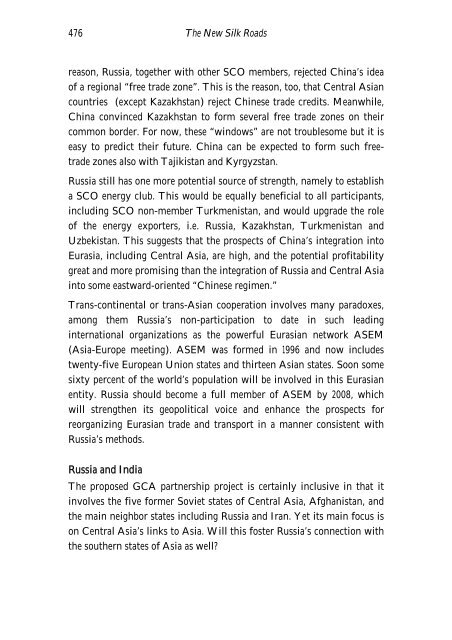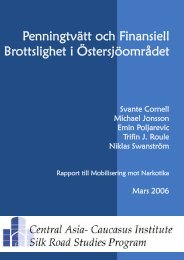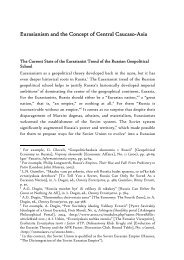Russia - Central Asia-Caucasus Institute and Silk Road Studies ...
Russia - Central Asia-Caucasus Institute and Silk Road Studies ...
Russia - Central Asia-Caucasus Institute and Silk Road Studies ...
You also want an ePaper? Increase the reach of your titles
YUMPU automatically turns print PDFs into web optimized ePapers that Google loves.
476<br />
The New <strong>Silk</strong> <strong>Road</strong>s<br />
reason, <strong>Russia</strong>, together with other SCO members, rejected China’s idea<br />
of a regional “free trade zone”. This is the reason, too, that <strong>Central</strong> <strong>Asia</strong>n<br />
countries (except Kazakhstan) reject Chinese trade credits. Meanwhile,<br />
China convinced Kazakhstan to form several free trade zones on their<br />
common border. For now, these “windows” are not troublesome but it is<br />
easy to predict their future. China can be expected to form such freetrade<br />
zones also with Tajikistan <strong>and</strong> Kyrgyzstan.<br />
<strong>Russia</strong> still has one more potential source of strength, namely to establish<br />
a SCO energy club. This would be equally beneficial to all participants,<br />
including SCO non-member Turkmenistan, <strong>and</strong> would upgrade the role<br />
of the energy exporters, i.e. <strong>Russia</strong>, Kazakhstan, Turkmenistan <strong>and</strong><br />
Uzbekistan. This suggests that the prospects of China’s integration into<br />
Eurasia, including <strong>Central</strong> <strong>Asia</strong>, are high, <strong>and</strong> the potential profitability<br />
great <strong>and</strong> more promising than the integration of <strong>Russia</strong> <strong>and</strong> <strong>Central</strong> <strong>Asia</strong><br />
into some eastward-oriented “Chinese regimen.”<br />
Trans-continental or trans-<strong>Asia</strong>n cooperation involves many paradoxes,<br />
among them <strong>Russia</strong>’s non-participation to date in such leading<br />
international organizations as the powerful Eurasian network ASEM<br />
(<strong>Asia</strong>-Europe meeting). ASEM was formed in 1996 <strong>and</strong> now includes<br />
twenty-five European Union states <strong>and</strong> thirteen <strong>Asia</strong>n states. Soon some<br />
sixty percent of the world’s population will be involved in this Eurasian<br />
entity. <strong>Russia</strong> should become a full member of ASEM by 2008, which<br />
will strengthen its geopolitical voice <strong>and</strong> enhance the prospects for<br />
reorganizing Eurasian trade <strong>and</strong> transport in a manner consistent with<br />
<strong>Russia</strong>’s methods.<br />
<strong>Russia</strong> <strong>and</strong> India<br />
The proposed GCA partnership project is certainly inclusive in that it<br />
involves the five former Soviet states of <strong>Central</strong> <strong>Asia</strong>, Afghanistan, <strong>and</strong><br />
the main neighbor states including <strong>Russia</strong> <strong>and</strong> Iran. Yet its main focus is<br />
on <strong>Central</strong> <strong>Asia</strong>’s links to <strong>Asia</strong>. Will this foster <strong>Russia</strong>’s connection with<br />
the southern states of <strong>Asia</strong> as well?






